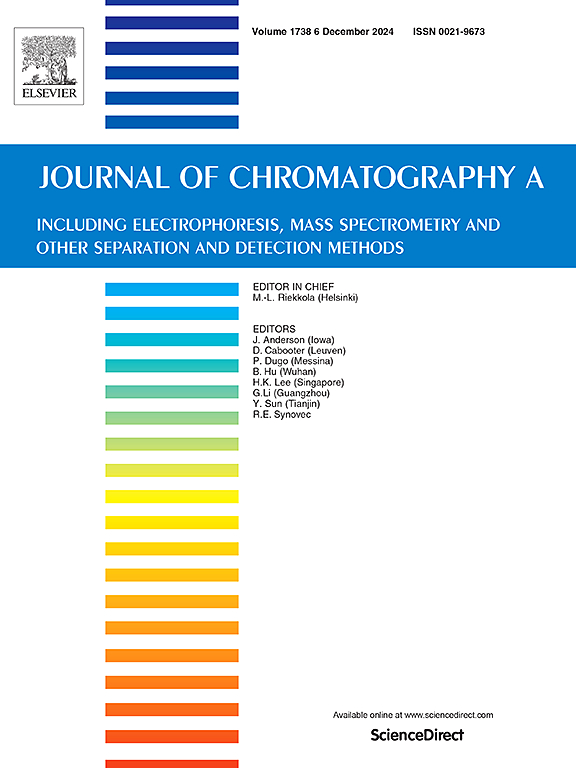Pore structure reconstruction to reveal the adsorption capacity limitation of current oligo-dT resins and guide new resin design
IF 3.8
2区 化学
Q1 BIOCHEMICAL RESEARCH METHODS
引用次数: 0
Abstract
In-depth knowledge of the pore structure of chromatographic resins is instrumental for better mechanistic understanding of adsorption performance, which can be translated into strategies to guide the design of new resins. Aiming to reveal the underlying reasons of low mRNA adsorption capacities of commercial oligo-dT resins, three-dimensional (3D) pore structure reconstruction was applied to relate key pore properties to the adsorption performance. The static 3D pore analysis revealed that the amount and connectivity of the accessible pores for 100 nm-sized mRNA reduced by over 90% and 46% compared with initial pore structure of resins, respectively, which led to discontinuous transport paths for mRNA. The dynamic simulations revealed that the strong hindrance of the firstly bound mRNA to the following mRNA molecules led to less than 10% of mRNA being able to penetrate into the resins with a depth of only 1–2 μm. Based on the digital material model, a virtual nanofiber-based macroporous resin was designed to explore its potential. Simulation results demonstrated that due to large pores and high connectivity, the new resin could allow over 91% of mRNA diffusion into the resin interior, showing great potential to improve the adsorption capacity of mRNA. This work provided a new method to evaluate the limitations of commercial oligo-dT resins and obtained some valuable guidance for the structure design of next-generation resins.
重建孔隙结构,揭示当前寡聚-dT 树脂的吸附能力限制,指导新树脂的设计
深入了解色谱树脂的孔结构有助于更好地从机理上理解其吸附性能,并将其转化为指导新树脂设计的策略。为了揭示商用寡聚-dT 树脂 mRNA 吸附能力低的根本原因,研究人员应用三维(3D)孔结构重构技术将关键孔性质与吸附性能联系起来。静态三维孔隙分析表明,与树脂的初始孔隙结构相比,100 nm 大小的 mRNA 可进入孔隙的数量和连通性分别减少了 90% 和 46% 以上,这导致 mRNA 的传输路径不连续。动态模拟结果表明,首次结合的 mRNA 对后续 mRNA 分子的强烈阻碍作用导致只有不到 10% 的 mRNA 能够穿透树脂,深度仅为 1-2 μm。在数字材料模型的基础上,设计了一种基于纳米纤维的虚拟大孔树脂,以探索其潜力。模拟结果表明,由于大孔和高连通性,新型树脂可使91%以上的mRNA扩散到树脂内部,在提高mRNA吸附能力方面显示出巨大潜力。这项工作为评估商用寡聚-dT 树脂的局限性提供了一种新方法,并为下一代树脂的结构设计提供了一些有价值的指导。
本文章由计算机程序翻译,如有差异,请以英文原文为准。
求助全文
约1分钟内获得全文
求助全文
来源期刊

Journal of Chromatography A
化学-分析化学
CiteScore
7.90
自引率
14.60%
发文量
742
审稿时长
45 days
期刊介绍:
The Journal of Chromatography A provides a forum for the publication of original research and critical reviews on all aspects of fundamental and applied separation science. The scope of the journal includes chromatography and related techniques, electromigration techniques (e.g. electrophoresis, electrochromatography), hyphenated and other multi-dimensional techniques, sample preparation, and detection methods such as mass spectrometry. Contributions consist mainly of research papers dealing with the theory of separation methods, instrumental developments and analytical and preparative applications of general interest.
文献相关原料
公司名称
产品信息
阿拉丁
Potassium ferrocyanide
阿拉丁
Thiocarbohydrazide
 求助内容:
求助内容: 应助结果提醒方式:
应助结果提醒方式:


